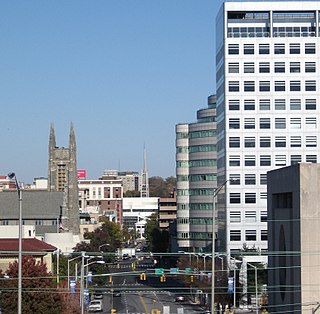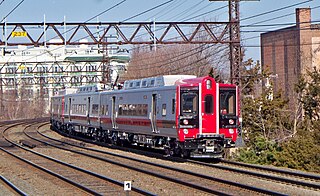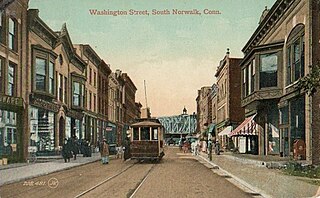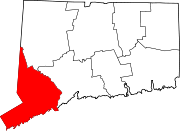
Fairfield County is a county in the southwestern corner of the U.S. state of Connecticut. As of the 2010 census, the county's population was 916,829, estimated to have increased by 3.6% to 949,921 in 2017, and decreased to 943,823 in 2018. The most populous county in the state, the county population represents a little over 25% of Connecticut's overall population and is one of its fastest-growing counties. The closest to the center of the New York megacity, the county contains four of the state's largest cities–Bridgeport (1st), Stamford (3rd), Norwalk (6th), and Danbury (7th)–whose combined population of 433,368 is nearly half the county's total population.

Fairfield is an affluent town in Fairfield County, Connecticut, United States. It borders the city of Bridgeport and towns of Trumbull, Easton, Weston, and Westport along the Gold Coast of Connecticut. As of the 2010 census, the town had a population of 59,404. In September 2014, Money magazine ranked Fairfield the 44th best place to live in the United States and the best place to live in Connecticut.

New Canaan is a town in Fairfield County, Connecticut, United States. The population was 19,738 according to the 2010 census. New Canaan is one of the wealthiest communities in the U.S; in 2008 it had the highest median family income in the country and was listed at #1 on CNN's list of "top-earning towns" in the United States.

Danbury is a city in Fairfield County, Connecticut, United States, located approximately 50 miles (80 km) northeast of New York City making it part of the New York metropolitan area. Danbury's population at the 2010 census was 80,893.

Stamford is a city in Fairfield County, Connecticut, United States. According to the US Census Bureau, the population of the city is 129,775 as of July 1, 2018. As of 2017, according to the Census Bureau, the population of Stamford had risen to 131,000, making it the third-largest city in the state and the seventh-largest city in New England. Approximately 30 miles from Manhattan, Stamford is in the Bridgeport-Stamford-Norwalk Metro area which is a part of the Greater New York metropolitan area.

Norwalk is a U.S. city located in southwestern Connecticut, in southern Fairfield County, on the northern shore of Long Island Sound. Norwalk lies within both the New York metropolitan area as well as the Bridgeport metropolitan area.
The Merritt Parkway is a limited-access parkway in Fairfield County, Connecticut, with a small section near the northern end in New Haven County. Designed for Connecticut's Gold Coast, the parkway is known for its scenic layout, its uniquely styled signage, and the architecturally elaborate overpasses along the route. As one of the first oldest parkways in the United States, it is designated as a National Scenic Byway and is also listed in the National Register of Historic Places. Signed as part of Route 15, it runs from the New York state line in Greenwich, where it serves as the continuation of the Hutchinson River Parkway, to Exit 54 in Milford, where the Wilbur Cross Parkway begins. Facing bitter opposition, the project took six years to build in three different sections, with the Connecticut Department of Transportation constantly requiring additional funding due to the area's high property value. The parkway was named for U.S. Congressman Schuyler Merritt. In 2010 the National Trust for Historic Preservation called the Merritt Parkway one of "America's 11 Most Endangered Historic Places".

Metro-North Railroad's New Haven Line runs from New Haven, Connecticut, southwest to Mount Vernon, New York. There it joins the Harlem Line, where trains continue south to Grand Central Terminal in Manhattan. The New Haven Line's ridership, at 125,000 weekday and 39 million annual passengers, ranks as the busiest rail line in the United States. The busiest station is Stamford, with 8.4 million passengers, or 21% of the line's ridership.

The Danbury Branch is a diesel branch of the Metro-North Railroad New Haven Line from downtown Norwalk, Connecticut north to Danbury, mostly single-tracked. It opened in 1852 as the Danbury and Norwalk Railroad. Until the early 1970s the branch originally had passenger service from Danbury to Canaan, Connecticut, to Pittsfield, Massachusetts. Metro-North took over operation of the line from Conrail in 1983.

The history of Norwalk, Connecticut ranges from pre-contact cultures and Native Americans to the 21st century.
There are an assortment of public, private, and parochial schools in Norwalk, Connecticut.

East Norwalk is a neighborhood of Norwalk, Connecticut, located mostly in Norwalk's third taxing district with segments of its northernmost area within the first and fifth taxing districts. As one of the earliest settlements of Norwalk, it was so marked with a block of 'suitably inscribed' 'native granite' formally located on the corner of Fitch Street and East Avenue.
The Fairfield County Railroad was chartered May 1835. Its goal was to give Danbury, Connecticut, a rail link with the outside world. It became the Danbury and Norwalk Railroad by 1850 which in turn did not operate until 1852. This company preceded Danbury and Norwalk Railroad and by 1950 ceased to exist.
The Central or Midtown section of Norwalk, Connecticut is an urbanized area in roughly the geographic center of the city, north of the South Norwalk neighborhood and the Connecticut Turnpike. Wall Street, West Avenue and Belden Avenue are the main thoroughfares. It has also been called "Norwalk Center" or "Downtown Norwalk".

Built in 1906, Beth Israel Synagogue was an historic Orthodox synagogue building located at 31 Concord Street in the South Norwalk section of the city of Norwalk, Connecticut. The Moorish Revival style building is the only known synagogue building in Connecticut displaying Moorish onion domes, and is an unusual example of an urban wood-frame synagogue. Since 1972, the building has been owned and occupied by the Canaan Institutional Baptist Church.

The South Main and Washington Streets Historic District — 68-139 Washington St. and 2-24 South Main St. is a historic district in South Norwalk, Connecticut. The 110-acre (45 ha) district encompasses 35 buildings and two other structures. Varied architectural styles from the late 19th and early 20th centuries include Romanesque Revival, Second Empire, and Italianate architecture. Half of the area first became part of the National Register of Historic Places in 1977. The district was increased in 1985 with the addition of nine buildings on 2.5 acres (1.0 ha) and again in 1999, with another 10 buildings on 3 acres (1.2 ha), roughly along North Main Street from Washington Street to Ann Street.

Bridgeport is a historic seaport city in the U.S. state of Connecticut. It is in Fairfield County, at the mouth of the Pequonnock River on Long Island Sound, 60 miles (97 km) from Manhattan and 40 miles (64 km) from The Bronx. It is bordered by the towns of Trumbull to the north, Fairfield to the west, and Stratford to the east.

The South Norwalk Railroad Bridge is an 1895 bridge in Norwalk, Connecticut. It carries the four sets of Metro-North railroad tracks across the busy intersection of Main Street and Washington Street in the South Norwalk section of the city. The bridge is adjacent to the South Norwalk Switch Tower Museum, which showcases the railroad switch tower where tracks were physically switched at the intersection of the Danbury Branch and the New Haven Line.
Connecticut Railway and Lighting Company was a streetcar and bus transit operator serving the region around Bridgeport, Norwalk, Derby, New Britain and Waterbury, Connecticut. It was formed in 1901 by United Gas Improvement Company of Philadelphia to manage the streetcar operations of the Connecticut Light and Power Company, which at the time included Central Railway and Electric Company, Norwalk Street Railway, and the Waterbury Traction Company. The newly formed Connecticut Railway and Lighting acquired Bridgeport Traction Company, Derby Street Railway, Milford Street Railway, Shelton Street Railway, Meriden, Southington and Compounce Tramway Company, and the Cheshire Street Railway. Connecticut Railway and Lighting was leased to the Consolidated Railway and in turn the Connecticut Company between 1906 and 1936. Streetcar operations were discontinued in 1937 when all lines were converted to bus. Transit operations continued until 1972, when all remaining bus operations were suspended and taken over by Connecticut Transit, except in Bridgeport- by the Greater Bridgeport Transit District in 1975.
The SoNo Collection is a shopping mall in the South Norwalk neighborhood of Norwalk, Connecticut. It was announced and developed by GGP Inc. in 2017, and continued by Brookfield Properties following its acquisition of GGP in 2018. The mall opened on October 11, 2019, and is the fourth mall in Fairfield County. The mall has adopted a phased opening process, including interactive art installations and community gathering spaces. It features southern Connecticut’s only Nordstrom and Bloomingdale's as the anchor stores. It is located next to Interstate 95 and Route 7.

































